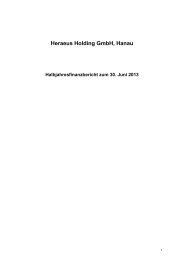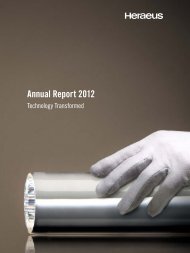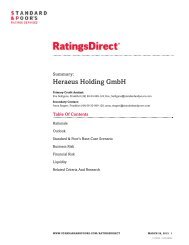english - About Heraeus
english - About Heraeus
english - About Heraeus
You also want an ePaper? Increase the reach of your titles
YUMPU automatically turns print PDFs into web optimized ePapers that Google loves.
charge is recognized where the recoverable amount is lower than the carrying amounts.<br />
Should the reasons for the impairment no longer be valid, an impairment loss is reserved,<br />
but not exceeding the value of the amortized cost.<br />
Deferred tax assets/liabilities: The realization of deferred tax assets depends on the future<br />
taxable profits of the respective Group companies. Corresponding allowances are recognized<br />
when it is uncertain if future earnings will be sufficient to take advantage of the tax<br />
loss carryforwards. The continued valuation of deferred tax assets is based on internal<br />
projections of the future earnings of the company.<br />
Receivables are valued at amortized cost using the effective interest method. Allowances<br />
for receivables are recognized in income. Evidence for an allowance could be, for example,<br />
when the financial difficulties of a debtor become known or payment delays occur. When<br />
assessing the need for an allowance, regional and sector-specific conditions are considered.<br />
Valuation adjustments are based on historical values, on client solvency and the age,<br />
period overdue, insurance policies, and customer-specific risks. Stated values for receivables<br />
are corrected using an allowance account.<br />
Pension provisions and similar obligations are measured using actuarial methods, applying<br />
the following valuation parameters, among others: future developments in compensation<br />
and pensions, the expected performance of plan assets, employee turnover, and the life<br />
expectancy of beneficiaries, as well as the discount rate. Actuarial gains and losses are<br />
recognized directly in retained earnings. They result from the variance between the actual<br />
development in pension obligations and pension assets and the assumptions made at the<br />
beginning of the year as well as the updating of actuarial assumptions.<br />
Other provisions cover, among other things, risks resulting from legal disputes. In order<br />
to determine the amount of the provisions, the facts related to each case, the size of the<br />
claim, claims awarded in similar cases, and independent expert advice are considered<br />
along with assumptions regarding the probability of a successful claim and the range of<br />
possible claims. The actual costs may deviate from these estimates. When discounting<br />
is applied to long-term provisions, assumptions have to be made with regard to the interest<br />
rate to be used.<br />
13
















